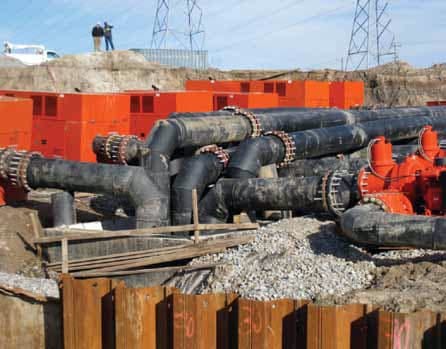HDPE Pipe for Bypass Pumping System

This project was conducted for the City of Memphis. The purpose of the project was to relocate a 96-inch sewer line that runs through the future site for the Mitsubishi Electric plant. A major key to the success of the Nonconnah Interceptor Project was the bypass pumping that needed to take place in order to keep the sewer lines active during this relocation. This 96-inch sewer line collects every ounce of sewage and wastewater running through the City of Memphis.
Six thousand feet of 18-inch HDPE pipe (SDR 32.5) was utilized and fused for the pump discharge lines. One thousand feet of 24-inch HDPE pipe (SDR 17) was utilized and fused for the pump suction tubes.
The solution was to strategically engineer a sewer bypass that was capable of handling approximately 140 MGD (million gallons a day) or 96,000 GPM (gallons per minute) @ 44’ TDH (total dynamic head). Heartland Pump was able to achieve these conditions by utilizing HDPE pipe from WL Plastics with their twelve Godwin CD400 diesel driven pumps. Most sewage systems use a piping material that is easily corroded, hard to handle and difficult to repair or replace. Polyethylene pipe from WL Plastics provided a cost-effective solution to this problem. Its inherent physical characteristics make it impervious to the extremely aggressive and corrosive materials associated with sewage systems. The use of HDPE pipe made the project significantly faster and easier due to the pipe’s lighter weight and ease of handling.
The pipe selection was crucial to the success of this project. “For temporary bypass pumping systems, HDPE pipe was the material of choice. It allowed us to quickly create a leak-free piping system that adhered to the contours of the site and was the most efficient hydraulically, “stated Brad Gould of Heartland Pumps. “This allows us to pump more sewage with less power. Also, the piping system is more durable which is important on a site with heavy equipment moving in tight quarters. In our opinion, HDPE pipe was the only choice for temporary bypass pumping.”